B-26-50 (A-26) Invader
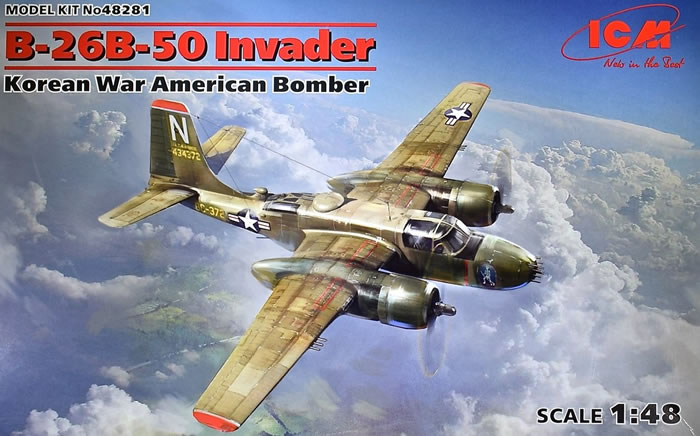
ICM, 1/48 scale
S
u m m a r y : |
Description and Item No.: |
ICM Kit No. 48281 - B-26-50 (A-26) Invader |
Contents and Media: |
227 parts in grey styrene, 10 clear parts, and one decal sheet with markings for 3 airframes. |
Price: |
GBP£47.99 EU Price (GBP£39.99 Export Price) plus shipping at Hannants
$99.99 plus shipping at Squadron
and hobby retailers worldwide |
Scale: |
1/35 |
Review Type: |
First Look |
Advantages: |
The kit is produced from a new mold: not a re-pop. Overall detail is very well done. Surface details are crisply molded and the inscribing is scale appropriate. The canopy parts are crystal clear and the quality decal sheet provides markings for 3 airframes. |
Disadvantages: |
None noted. |
Recommendation: |
The engineering is simple, the details are well done and abundant, the canopy parts are crystal clear and the result will be an impressive model—Nicely done, ICM! |
Reviewed by John Miller

Airfix's 1/72 scale Sea King is available online from Squadron.com
Saturday, Skyway Model Shop, coffee, and my normal weekly visit; all is right with the word. Then, Zang!-- 1/48th scale A-26 Invader that’s not the ole Monogram kit?!?!?!?!
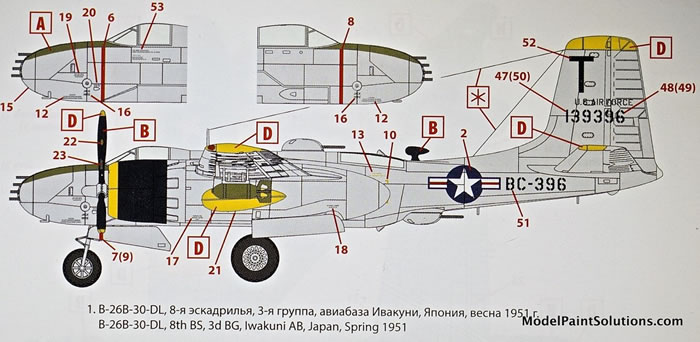
My right hand reached for my wallet before my left could stop it. This kit is a beaut and very welcome to those that’ve long clamored for a new A-26---Well done, ICM!
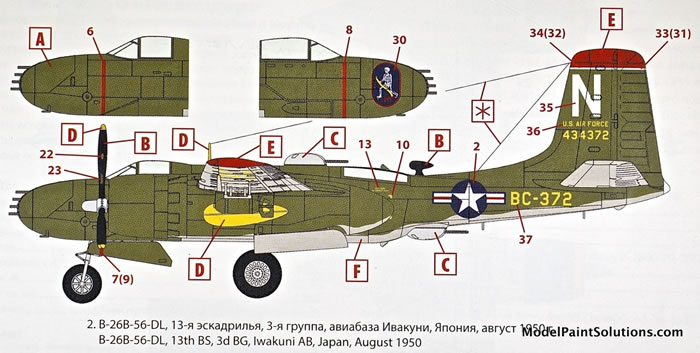
Now if someone would be willing to tackle a new-mold B-26 Marauder (oh please, please).
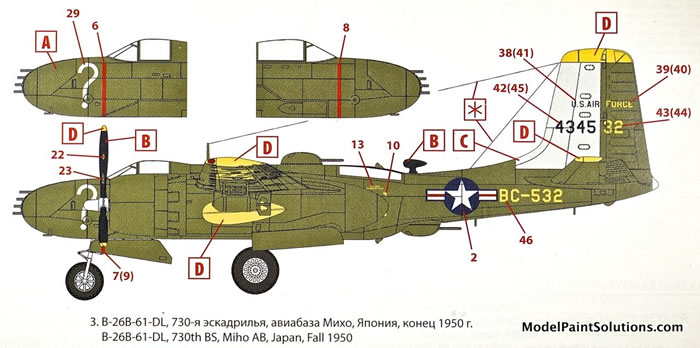
Background
The Douglas A-26 Invader (designated B-26 between 1948 and 1965) is an American twin-engined, light bomber, and ground attack aircraft. Built by Douglas Aircraft Company during World War II, the Invader also saw service during several major Cold War conflicts. A limited number of highly modified United States Air Force aircraft served in Southeast Asia until 1969. It was a fast aircraft capable of carrying a large bomb load. A range of guns could be fitted to produce a formidable ground-attack aircraft.
A re-designation of the type from A-26 to B-26 led to confusion with the Martin B-26 Marauder, which first flew in November 1940, some 20 months before the Douglas design's maiden flight. Although both types were powered by the widely used Pratt & Whitney R-2800 Double Wasp eighteen-cylinder, double-row, radial engine, they were completely different and separate designs – the Martin bomber originated in 1939, with more than twice as many Marauders (nearly 5,300) produced in comparison to the Douglas design.
Design and Development:
The A-26 was Douglas Aircraft's successor to the A-20 (DB-7) Havoc, also known as Douglas Boston, one of the most successful and widely operated types flown by Allied air forces in World War II.
Designed by Ed Heinemann, Robert Donovan, and Ted R. Smith, the innovative NACA 65-215 laminar flow airfoil wing of the A-26 was the work of project aerodynamicist A.M.O. Smith. The Douglas XA-26 prototype (AAC Ser. No. 41-19504) first flew on 10 July 1942 at Mines Field, El Segundo, with test pilot Benny Howard at the controls. Flight tests revealed excellent performance and handling, but engine cooling problems led to cowling changes and elimination of the propeller spinners on production aircraft. Repeated collapses during testing led to reinforcement of the nose landing gear.
The A-26 was originally built in two different configurations. The A-26B had a gun nose, which originally could be equipped with a combination of armament including .50 caliber machine guns, 20mm or 37mm auto cannon, or even a 75mm pack howitzer (which was never used operationally). Normally the gun nose version housed six (or later eight) .50 caliber machine guns, officially termed the "all-purpose nose", later commonly known as the "six-gun nose" or "eight-gun nose". The A-26C's "glass" nose, officially termed the "Bombardier nose", contained a Norden bombsight for medium altitude precision bombing. The A-26C nose section included two fixed M-2 guns, later replaced by underwing gun packs or internal guns in the wings.
After about 1,570 production aircraft, three guns were installed in each wing, coinciding with the introduction of the "eight-gun nose" for A-26Bs, giving some configurations as many as 14 .50 in (12.7 mm) machine guns in fixed forward mounts. An A-26C nose section could be replaced with an A-26B nose section, or vice versa, in a few man-hours, thus physically (and officially) changing the designation and operational role. The "flat-topped" canopy was changed in late 1944 after about 820 production aircraft, to a clamshell style with greatly improved visibility.
Alongside the pilot in an A-26B, a crewmember typically served as navigator and gun loader for the pilot-operated nose guns. In an A-26C, that crewmember served as navigator and bombardier, and relocated to the nose section for the bombing phase of an operation. A small number of A-26Cs were fitted with dual flight controls, some parts of which could be disabled in flight to allow limited access to the nose section. Access was through the lower section of the right-hand instrument panel, which was open to allow access to the nose for the bombardier, who would normally sit next to the pilot. This was similar to British designs like the Lancaster, Blenheim/Beaufort, and Wellington. A tractor-style "jump seat" was located behind the "navigator's seat." In most missions, a third crew member in the rear gunner's compartment operated the remotely controlled dorsal and ventral gun turrets, with access to and from the cockpit possible via the bomb bay only when that was empty. The gunner operated both dorsal and ventral turrets via a novel and complex (and problematic) dual-ended periscope sight, which was a vertical column running through the center of the rear compartment, with traversing and elevating/depressing periscope sights on each end. The gunner sat on a seat facing rearward, and looked into a binocular periscope sight mounted on the column, controlling the guns with a pair of handles on either side of the column. When aiming above the centerline of the aircraft, the mirror in the center of the column would flip, showing the gunner what the upper periscope was seeing. When he pressed the handles downward, as the bead passed the centerline the mirror would automatically flip, transferring the sight "seamlessly" to the lower periscope. The guns would aim wherever the periscope was aimed, automatically transferring between upper and lower turrets as required, and computing for parallax and other factors. While novel and theoretically effective, a great deal of time and trouble was spent trying to get the system to work effectively, which delayed production, and it was difficult to keep maintained in the field even once production started.
Operational History:
Pacific:
The Douglas company began delivering the production model A-26B to the United States Army Air Forces (USAAF) on 10 September 1943, with the new bomber first seeing action with the Fifth Air Force in the Southwest Pacific theater on 23 June 1944, when Japanese-held islands near Manokwari were attacked. The pilots in the 3rd Bomb Group's 13th Squadron, "The Grim Reapers", who received the first four A-26s for evaluation, found the view from the cockpit to be restricted by the engines and thus inadequate for low-level attack. General George Kenney, commander of the Far East Air Forces stated that, "We do not want the A-26 under any circumstances as a replacement for anything.”
Until changes could be made, the 3d Bomb Group requested additional Douglas A-20 Havocs, although both types were used in composite flights. The 319th Bomb Group worked up on the A-26 in March 1945, joining the initial 3rd BG, with the 319th flying until 12 August 1945. The A-26 operations wound down in mid-August 1945 with only a few dozen missions flown. Several of the A-20 and B-25 AAF units in the Pacific received the A-26 for trials, in limited quantities.
Europe:
Douglas needed better results from the Invader's second combat test, so A-26s began arriving in Europe in late September 1944 for assignment to the Ninth Air Force. The initial deployment involved 18 aircraft and crews assigned to the 553d Squadron of the 386th Bomb Group. This unit flew its first mission on 6 September 1944. No aircraft were lost on the eight test missions, and the Ninth Air Force announced that it was happy to replace all of its A-20s and B-26s with the A-26 Invader.
The first group to fully convert to the A-26B was 416th Bombardment Group with which it entered combat on 17 November, and the 409th Bombardment Group, whose A-26s became operational in late November. Due to a shortage of A-26C variants, the groups flew a combined A-20/A-26 unit until deliveries of the glass-nose version caught up. Besides bombing and strafing, tactical reconnaissance and night interdiction missions were undertaken successfully. In contrast to the Pacific-based units, the A-26 was well received by pilots and crew alike, and by 1945, the 9th AF had flown 11,567 missions, dropping 18,054 tons of bombs, recording seven confirmed kills while losing 67 aircraft.
In Italy the Twelfth Air Force's 47th Bomb Group also received the A-26, starting in January 1945. They were used against German transport links, but also for direct support and interdiction against tanks and troop concentrations in the Po valley in the final campaigns in Italy.
Postwar Era:
United States:
With the establishment of the United States Air Force as an independent service in 1947, the Strategic Air Command operated the now-redesignated B-26 as an RB-26 reconnaissance aircraft in service from 1949 through 1950. U.S. Air Forces in Europe continued operating the redesignated B-26 until 1957 and the Tactical Air Command operated the aircraft as both a B-26 and later redesignated back to A-26, the final variant designated as B-26K until 1966, when it again became the A-26A. This final version continued in service through the late 1960s with active duty special operations TAC units, and through 1972 with TAC-gained special operations units of the Air National Guard.
The U.S. Navy also obtained a number of Invaders from the Air Force and employed these aircraft in their utility squadrons (VU) for target towing and general utility use until superseded by the DC-130A variant of the C-130 Hercules. The Navy designation was JD-1 and JD-1D until 1962, when the JD-1 was redesignated UB-26J and the JD-1D was redesignated DB-26J. The CIA also used the type for covert operations.
The last A-26 in active US service was assigned to the Air National Guard; that aircraft being retired from military service in 1972 by the U.S. Air Force and the National Guard Bureau and donated to the National Air and Space Museum.
Korean War:
B-26 Invaders of the 3d Bombardment Group, operating from bases in southern Japan, were among the first USAF aircraft engaged in the Korean War, carrying out missions over South Korea on 27 and 28 June, before carrying out the first USAF bombing mission on North Korea on 29 June 1950, when they bombed an airfield outside of Pyongyang.
On 10 August 1950, the Air Force Reserve's 452d Bombardment Wing was activated for Korean service. It flew its first missions in November 1950 from Itazuke, Japan, providing daylight support, with the 3rd Bomb Wing, consisting of the 8th, 13th and 90th Bomb Squadrons, flying night missions. Because of the Chinese intervention, it was forced to find another base and moved to Miho Air Base on the west coast of Honsh?. In early 1951 it moved to Pusan East (K-9) Air Base and continued its daylight as well as night intruder missions. In June 1951, it joined the 3rd Bomb Wing (Kunsan (K-8)) in night activity only, dividing the target areas, with the 452nd taking the eastern half and the 3rd the western. For its efforts in the Korean War, it was awarded two unit citations and the Korean Presidential Citation. It also received credit for eight campaign operations.
In May 1952 it was inactivated and all of its aircraft and equipment along with its regular air force personnel were absorbed by the 17th Bomb Wing. During its time as an active unit, the 452nd flew 15,000 sorties (7000 at night) with a loss of 85 crewmen.
B-26s were credited with the destruction of 38,500 vehicles, 406 locomotives, 3,700 railway trucks, and seven enemy aircraft on the ground. On 14 September 1951, Captain John S. Walmsley, Jr. attacked a supply train. When his guns jammed, he illuminated the target with his searchlight to enable his wingmen to destroy the train. Walmsley was shot down and posthumously awarded the Medal of Honor. Invaders carried out the last USAF bombing mission of the war 24 minutes before the Armistice Agreement was signed on 27 June 1953.
In addition to the standard attack versions of the B-26, which flew night interdiction missions, a small number of modified WB-26s and RB-26s of the 67th Tactical Reconnaissance Wing flew critical weather observation and reconnaissance missions in supporting roles.
Southeast Asia:
The first B-26s to arrive in Southeast Asia were deployed to Takhli RTAFB, Thailand in December 1960. These unmarked aircraft, operated under the auspices of the U.S. CIA, were soon augmented by an additional 16 aircraft, 12 B-26Bs and B-26Cs plus four RB-26Cs under Operation Millpond. The mission of all of these aircraft was to assist the Royal Lao Government in fighting the Pathet Lao. The repercussions from the Bay of Pigs invasion meant that no combat missions are known to have been flown, although RB-26Cs operated over Laos until the end of 1961. The aircraft were subsequently operated in South Vietnam under Project "Farm Gate". The only other deployment of B-26 aircraft to Laos prior to the introduction of the B-26K/A-26A, was the deployment of two RB-26C aircraft, specifically modified for night reconnaissance, deployed to Laos between May and July 1962 under Project Black Watch. These aircraft, initially drawn from Farm Gate stocks, were returned upon the end of these missions.
The aircraft from Laos participated in the early phase of the Vietnam War with the USAF, but with Vietnamese markings as part of Project Farm Gate. Though Farm Gate operated B-26Bs, B-26Cs, and genuine RB-26Cs, many of these aircraft were operated under the designation RB-26C, though they were used in a combat capacity. During 1963, two RB-26C were sent to Clark AB in the Philippines for modifications, though not with night systems as with those modified for Black Watch. The two aircraft returned from Black Watch to Farm Gate were subsequently given the designation RB-26L to distinguish them from other modified RB-26C, and were assigned to Project Sweet Sue. Farm Gate's B-26s operated alongside the other primary strike aircraft of the time, the T-28 Trojan, before both aircraft types were replaced by the Douglas A-1 Skyraider. The B-26s were withdrawn from service in February 1964 after two accidents related to wing spar fatigue, one during combat in Southeast Asia in August 1963 and one during an airpower demonstration at Eglin AFB, Florida in February 1964.
On 11 February 1964, two pilots from the 1st Air Commando Wing stationed at Hurlburt Field, Fla., died in the crash of a B-26 on Range 52 at Eglin AFB when it lost a wing during pull-out from a strafing pass. The aircraft was participating in a demonstration of the Special Air Warfare Center's counter insurgency capabilities and had completed a strafing run when the accident occurred. SAWC had presented the demonstration on an average of twice each month for the previous 21 months. B-26 aircraft used by USAF Commandos in Vietnam were grounded 8 April 1964, following an official investigation into the 11 February accident. B-26 aircraft in use by the South Vietnamese Air Force were also grounded in accordance with the U.S. ruling.
In response to this, the On Mark Engineering Company of Van Nuys, California was selected by the Air Force to extensively upgrade the Invader for a counterinsurgency role. The first production flight of the B-26K was on 30 May 1964 at the Van Nuys Airport. On Mark converted 40 Invaders to the new B-26K Counter-Invader standard, which included upgraded engines, propellers, and brakes, re-manufactured wings, and wing tip fuel tanks, for use by the 609th Special Operations Squadron. In May 1966, the B-26K was re-designated A-26A for political reasons (Thailand did not allow the U.S. to have bombers stationed in country at the time, so the Invaders were redesignated with an "A", for attack aircraft) and deployed in Thailand to help disrupt supplies moving along the Ho Chi Minh trail. Two of these aircraft were further modified with a Forward Looking Infrared (FLIR system) under project Lonesome Tiger, as a part of Operation Shed Light.
CIA:
In early 1961, about 20 B-26Bs, most converted from B-26C configuration, were 'sanitized' at Duke Field (also known as Auxiliary Field Three at Eglin AFB), Florida. They had defensive armament removed, and were fitted with the eight-gun nose, underwing drop tanks, and rocket racks. They were flown to a CIA-run base in Guatemala where training was under way of B-26, C-46 and C-54 Cuban exile air crews by personnel from the Alabama Air National Guard. After transfer to Nicaragua in early April 1961, they were painted in the markings of the FAR (Fuerza Aérea Revolucionaria), the air force of the Cuban government.
On 15 April 1961, crewed by Cuban exiles, eight B-26s of the FAL (Fuerza Aérea de Liberación) attacked three Cuban airfields, in an attempt to destroy FAR combat aircraft on the ground. On 17 April 1961, FAL B-26s supported the seaborne Bay of Pigs Invasion of Cuba. The conflict ended on 19 April, after the loss of nine FAL B-26s, 10 Cuban exiles and 4 American aircrew in combat. The FAR flew B-26Cs in the conflict, one of which was shot down by a CIA 'command ship' with the loss of 4 Cuban aircrew.
The CIA contracted pilots, some previously employed during the Bay of Pigs Invasion, to fly B-26Ks for ground attack against Simba rebels in the Congo Crisis. Newly remanufactured B-26K Counter-Invaders were delivered to the Congo via Hurlburt Field in 1964.
(Edited from Wikipedia)
In the double-lidded, heavy-duty box typical of this manufacture are 8 sprues of grey plastic, one of clear, and one decal sheet. All sprues are provided in a re-sealable bag and the clear sprue is separately bagged (nice).
The overall initial impression is very positive. Surface details are abundant, beautifully rendered, and scale-appropriate: inscribed and outscribed (in relief). There is very little flash on most parts although some clean up will be required prior to assembly.
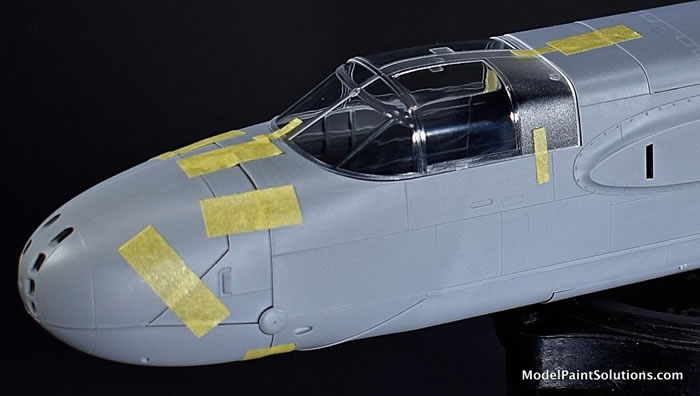
Parts layout and engineering are conventional with the cockpit and bomb bay details sufficient for this scale. For those who want a bit more, I suspect there’ll be a plethora of aftermarket details for this kit available very soon.
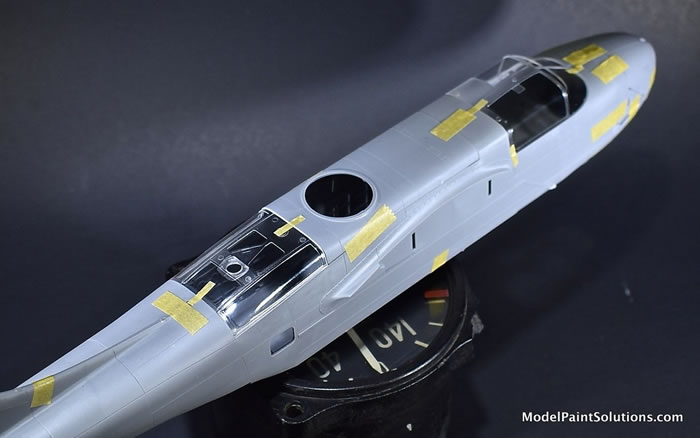
A quick test fit of the fuselage halves, nose section, and canopy revealed no issues. The fit of all the parts tested was spot-on.
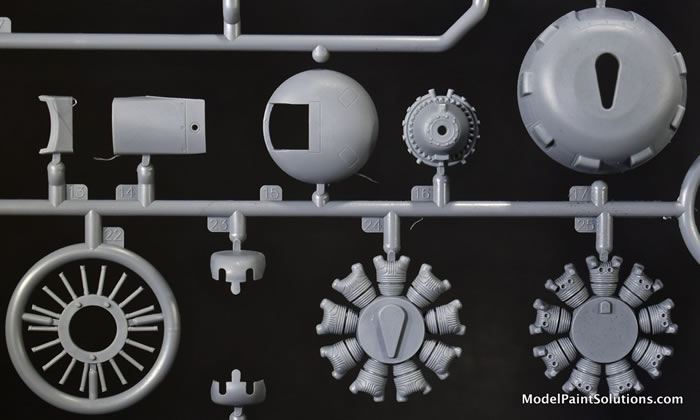
Interestingly, there are two canopies provided, one open and one closed, however, no mention or depiction of an open-canopy option is provided in the instructions.
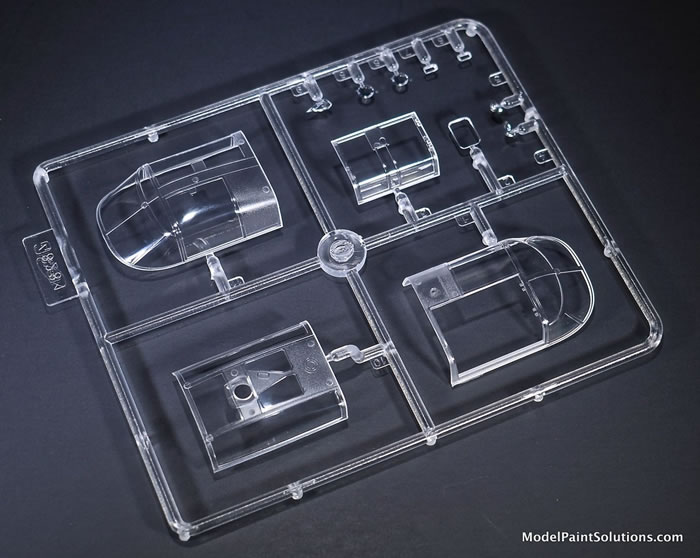
I see no hidden issues laying in wait. This looks to be a quick and easy build that will result in a large and impressive model. I’ll leave any further considerations of accuracy to those with more knowledge of the subject but it sure looks like an Invader to me.
Marking Options
The decals, by ICM, are crisply printed with good color density and hue.
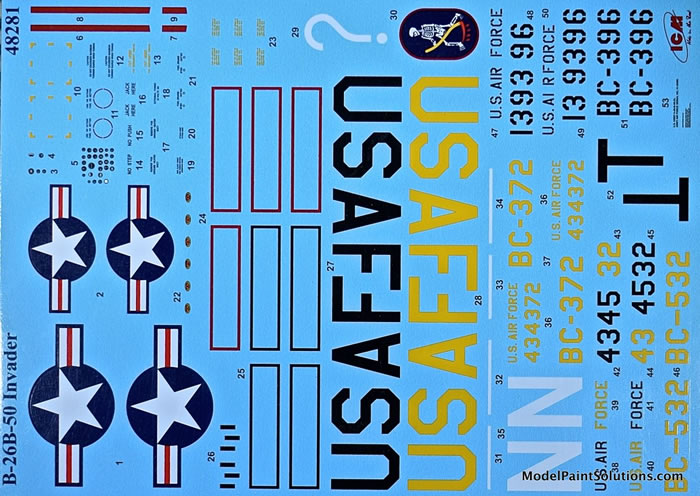
Markings for three schemes are provided as follows:
-
B-26B-30-DL, 8th BS, 3rd BG, Iwakuni AB, Japan, Spring, 1951.
-
B-26B-56-DL, 13th BS, 3rd BG, Iwakuni AB, Japan, August, 1950.
-
B-26B-61-DL, 730th BS, Miho AB, Japan, Fall, 1950.
The engineering is simple, the details are well done and abundant, the canopy parts are crystal clear and the result will be an impressive model—Nicely done, ICM!
Kit purchased by reviewer, again!
For more on this review visit Modelpaintsolutions.com.
Review and Images Text Copyright © 2019 by Model Paint Solutions
Page Created 29 October, 2019
Last updated
31 October, 2019
Back to HyperScale Main Page
Back to Reviews Page

|
Home
| What's New |
Features |
Gallery |
Reviews |
Reference |
Forum |
Search